
</ img>
vivo V20 makes a pleasant overall impression and does not have any critical problems, considering
vivo V20
A mid-range smartphone with 6.44-inch FullHD + AMOLED display, Snapdragon 720G octa-core processor, 8 GB of RAM, 128 GB of internal storage and a microSD slot. Powered by a 4000mAh battery. Out of the box, it runs on the new Android 11 OS with the proprietary shell Funtouch OS 11.
Rozetka
Foxtrot
Citrus
Hello

first on Android 11
</ img>
6 reasons to buy vivo V20:
- bright and high quality AMOLED screen;
- fresh Android 11 with Funtouch 11 shell;
- the presence of a separate slot for MicroSD and 3.5 mm jack;
- sensible main camera;
- slim, lightweight body and interesting back panel design;
- fast charging and pleasant battery life.
3 reasons not to buy vivo V20:
- I would like a screen refresh rate of 90 or 120 Hz;
- there are strong competitors in this price category;
- the look of the bezel straight from last year.
Fast passage:
- What is included?
- What does the vivo V20 look like?
- How good is the screen?
- What are the unlock methods?
- What about performance, memory, sound and autonomy?
- What about the interface?
- How good are the cameras?
- In the dry residue
What is included?

</ img>
vivo V20 comes in a standard boxsizes in a beautiful dark blue color with a small amount of printing: model name, basic technical information and indication of memory capacity. Inside there is the smartphone itself, a protective silicone bumper, a wired headset, a 33W Vivo FlashCharge 2.0 charger, a Type-C cable, a tool for removing the tray and documentation. The protective film is immediately on the screen.

</ img>
What does the vivo V20 look like?

</ img>
The body of vivo V20 is made of glass and is veryhigh-quality plastic, feels pleasant and expensive in the hand. But the appearance is devoid of any originality: from the front, the smartphone looks like a typical last year’s model. This year, manufacturers began to move away from using a teardrop cutout for the front camera towards options with holes (which seems to me much more aesthetically pleasing than droplets/unibrows, but this is a matter of taste). Vivo V20 has a drop-shaped cutout, not the thinnest frames on three sides and an even wider chin. Above the screen is a wide slot for the earpiece.

</ img>
The frame has the usual streamlined shape and is mademade of plastic with a glossy finish. The plastic is of high quality: at first there was an impression that it was metal. The controls are placed in their usual places: on the right is the volume rocker and power button. The latter has a textured surface.

</ img>
On the left is only the card tray. It provides space for both a pair of SIM cards and a microSD memory card.

</ img>

</ img>


On the bottom there is an external speaker, microphone, Type-C and a standard headphone jack. Manufacturers are not in a hurry to remove it from the models of the middle price segment.

</ img>
At the top there is only an additional microphone.

</ img>
The back panel of the smartphone looks veryInteresting. It is made of frosted glass. Fingerprints are practically invisible on it, and the “clutch” with the palm it is much better. We received a brighter blue version for review, which shimmers to pink and orange. For conservatives there is matte black.

</ img>

</ img>


Despite the fact that the rear camera unit in thisyear, almost all smartphone manufacturers are difficult to distinguish from each other, vivo still managed to make it a little more original. This is a large rectangle with minimal rounded corners, in which all three cameras are located under the common black glass, and under them is a thin metal insert with an oblong flash. At the same time, the module does not protrude too much beyond the body.

</ img>
Taking into account modern trends to producesmartphones exclusively with huge screens, we can say that Vivo V20 turned out to be very compact and thin: 161.3×74.2×7.4 mm. At the same time, the weight is 171 g, the smartphone can be called light. They are quite comfortable to use with one hand.
</ p>How good is the screen?

</ img>
The vivo V20 uses flat 6.44-inch AMOLED display with FullHD+ resolution, 2400x1080 (20:9 aspect ratio), pixel density of about 409 ppi. In terms of picture quality, the screen is very pleasing: rich colors, maximum viewing angles, an impressive reserve of brightness and the contrast characteristic of AMOLED with the “real” in black. The Always on Display feature is also present.

</ img>
The only thing that's a little disappointing is the screen refresh rate.- 60 Hz, although in this price range there are models with 90 and 120 Hz. Not critical for those who have not yet used smartphones with 90/120 Hz screens. The customization options are standard: a dark interface theme, an eye protection mode with the ability to auto-activate on a schedule, font size and a flicker-reducing function (DC Dimming). There are three color display modes: “standard”, “normal” and “bright”, there is the ability to manually adjust the color temperature.

</ img>

</ img>

</ img>

</ img>

</ img>

</ img>

</ img>

</ img>

</ img>

</ img>

</ img>

</ img>












In “bright” maximum brightness modewas 415.542 cd/m², a very good figure. The color gamut is much wider than sRGB, which is typical for AMOLED matrices. The color temperature in this mode is noticeably “higher”, the screen goes into cool shades. Although, thanks to the ability to manually adjust the color temperature, the screen can be adjusted to suit you:

</ img>

</ img>

</ img>

</ img>

</ img>





In “normal” mode, the picture is much closer to natural, and the color gamut is close to sRGB. The maximum brightness remains at the same level: 415.537 cd/m².
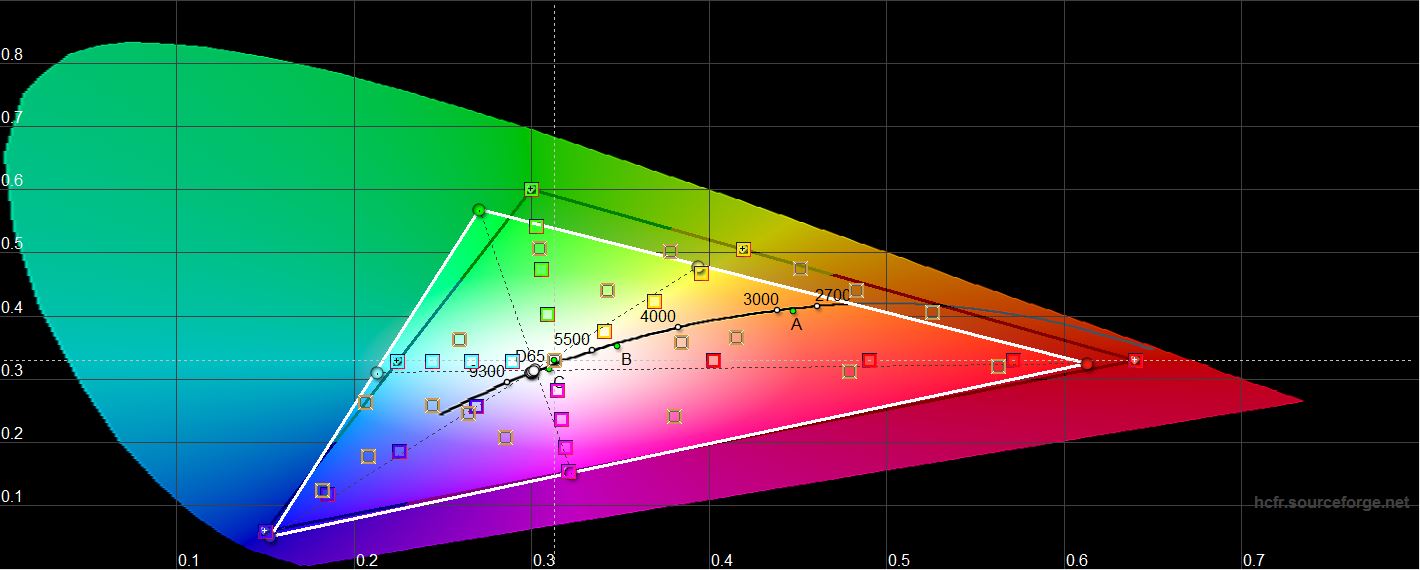
</ img>

</ img>

</ img>

</ img>

</ img>





Comparison with other models:
Device name
White field brightness,
cd / m2
The brightness of the black field,
cd / m2
Contrast
vivo V20
415.542
0
∞
vivo X50
464.169
0
∞
OPPO Reno3 Pro
511.439
0
∞
Huawei P40
428.732
0
∞
Samsung Galaxy A41
398.38
0
∞
realme X2 Pro
473.848
0
∞
What are the unlock methods?
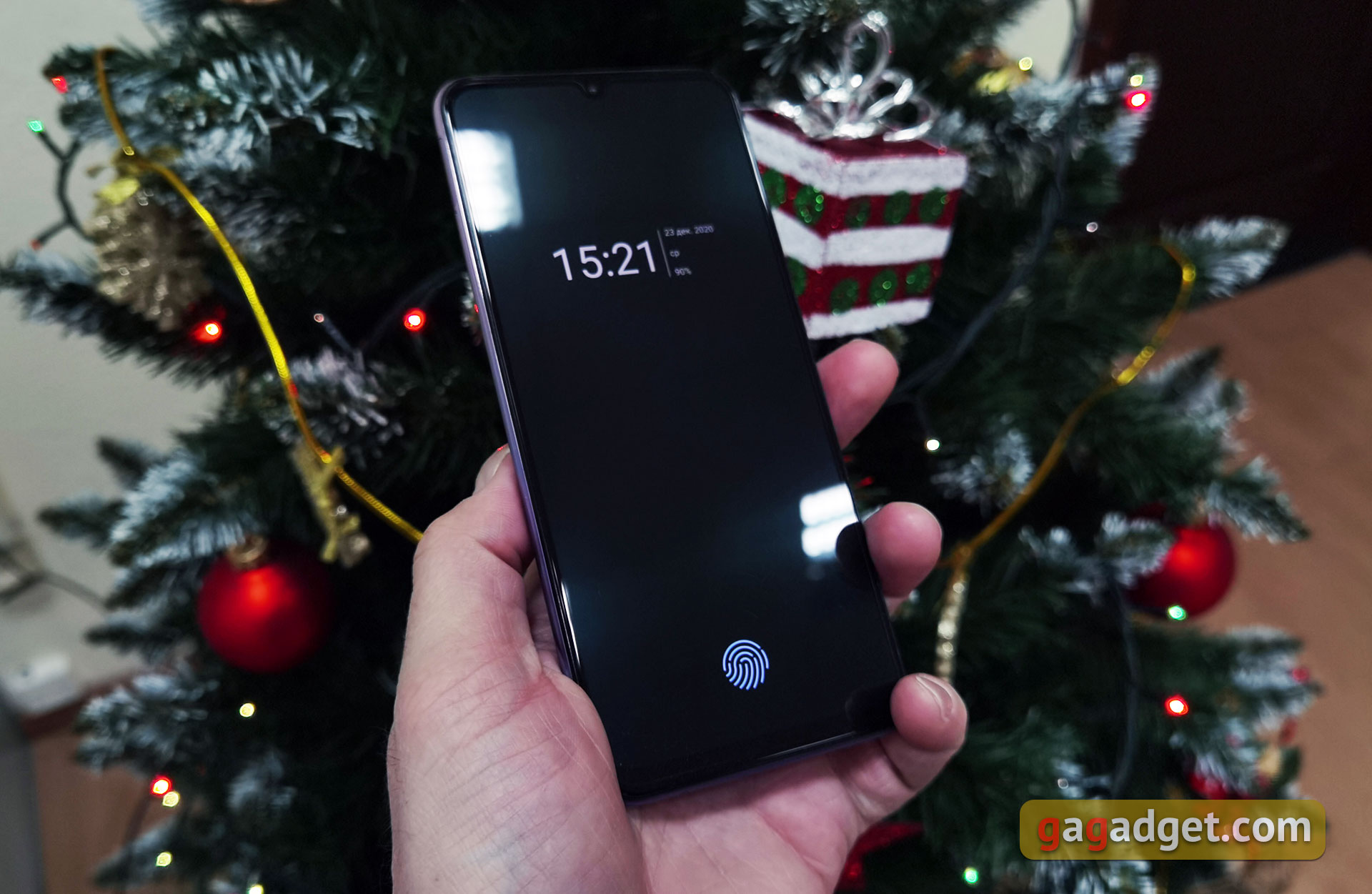
</ img>
A smartphone can recognize its owner in two ways:standard methods: finger scanner and face recognition. The scanner is located under the screen, it is optical: the finger is illuminated during scanning, and cannot work with wet fingers. There were no problems with the accuracy and speed of its operation while using the Vivo V20. Face recognition also works quite quickly, provided there is sufficient lighting. The already familiar function of increasing the screen brightness for recognition in poor lighting, but in complete darkness it, of course, does not help much.

</ img>

</ img>

</ img>

</ img>

</ img>

</ img>

</ img>

</ img>

</ img>









What about performance, memory, sound and autonomy?
Already responsible for smartphone performancethe familiar Qualcomm Snapdragon 720G processor, which has proven itself to be a successful solution in the mid-price segment. The processor is manufactured using an 8-nm process technology, includes two Kryo 465 Gold cores clocked at 2.3 GHz and six Kryo 465 Silver cores at 1.8 GHz, graphics accelerator - Adreno 618. RAM - 8 GB LPDDR4x, built-in - 128 GB UFS 2.1 . In synthetic tests, the results are quite consistent with the average price range to which the smartphone belongs. We have already owned smartphones on this platform, and vivo V20 demonstrates similar performance in synthetic tests, typical for the mid-range segment. No surprises.

</ img>

</ img>

</ img>

</ img>

</ img>
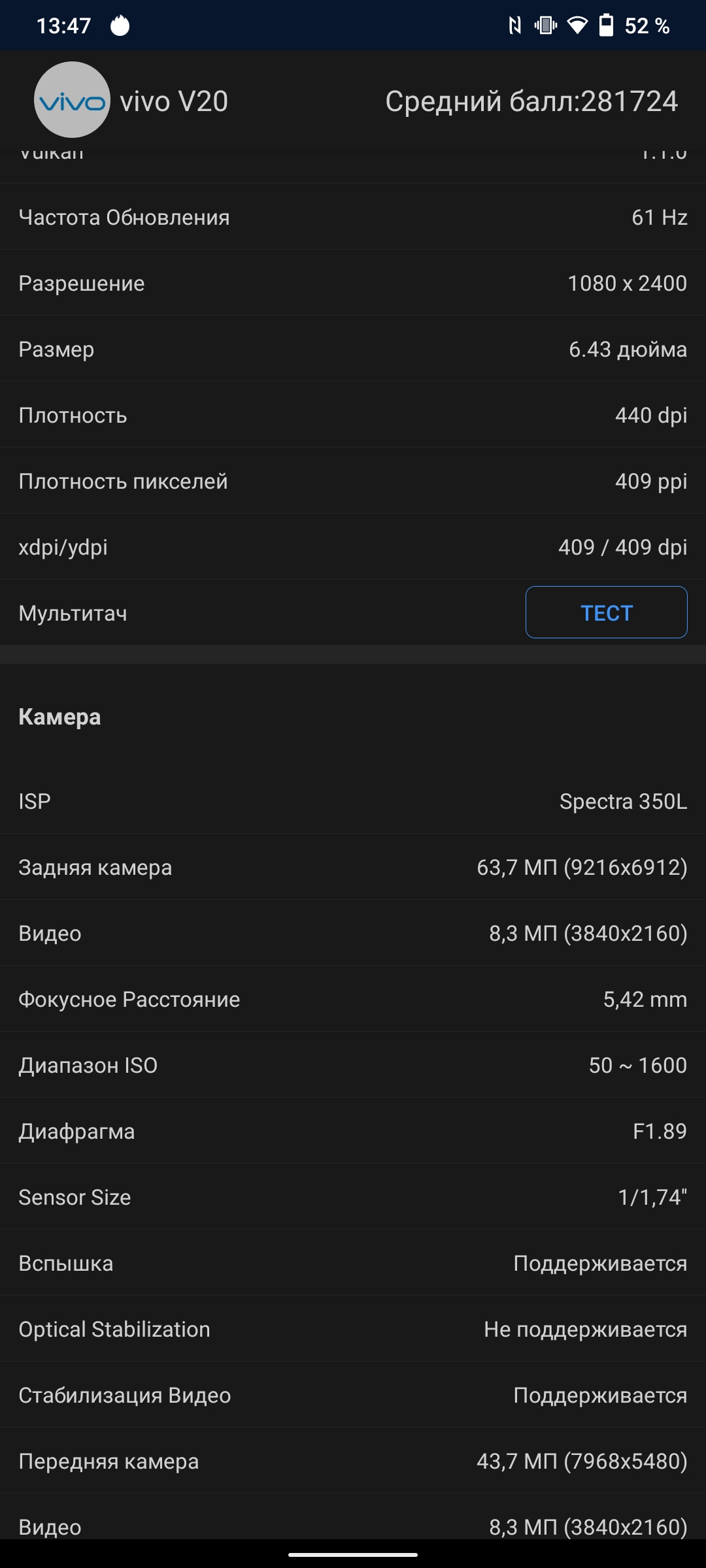
</ img>
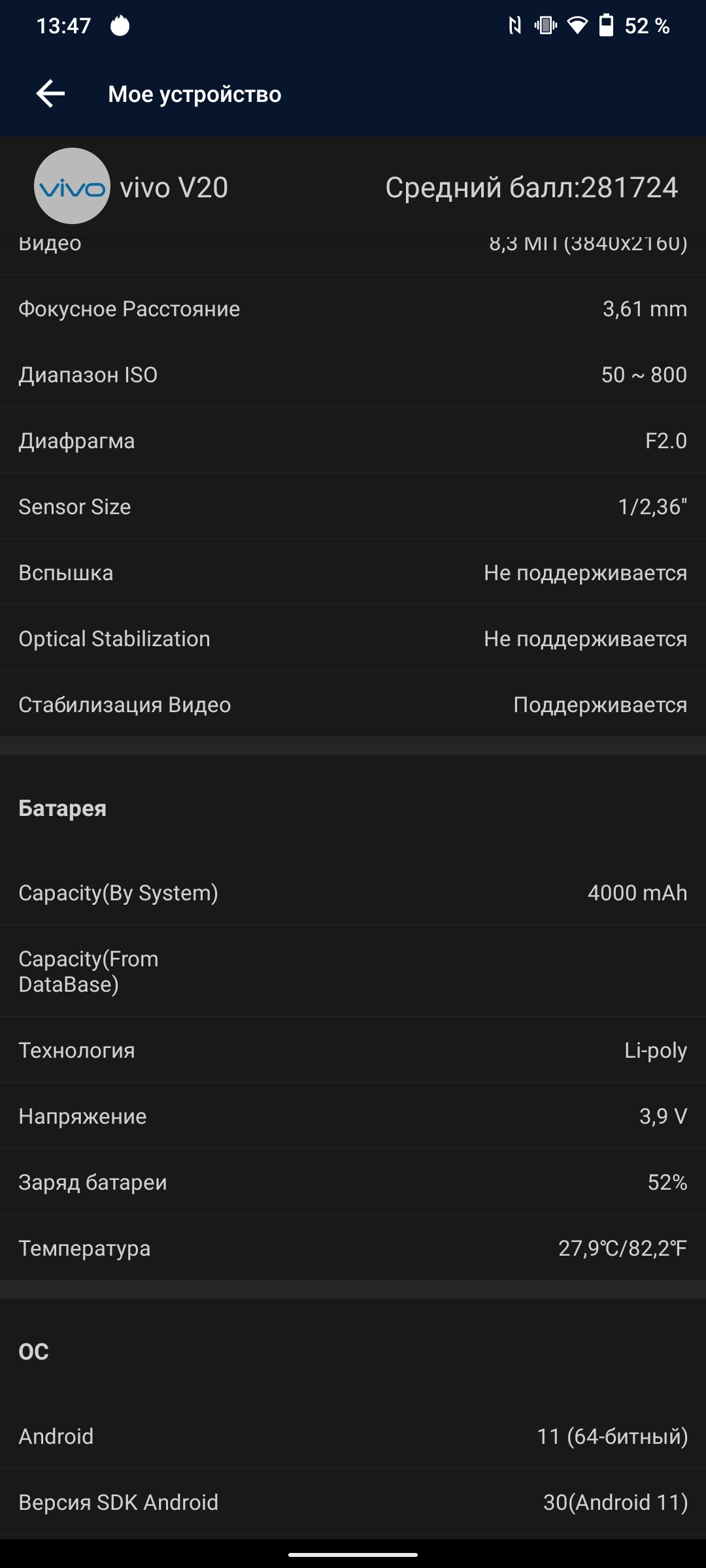
</ img>

</ img>

</ img>

</ img>

</ img>

</ img>

</ img>

</ img>

</ img>

</ img>

</ img>

</ img>

</ img>

</ img>

</ img>

</ img>

</ img>

</ img>

</ img>

























With “everyday” useThere are no performance problems: the shell is not sluggish, heavy applications open quickly. Popular modern smartphone games “pulls” no problem on medium or high settings. Periodic small drops in FPS occur only in PUBG Mobile, which is observed in the vast majority of mid-segment smartphones, and even in some flagships.

</ img>

</ img>

</ img>

</ img>

</ img>

</ img>

</ img>

</ img>

</ img>

</ img>

</ img>











The Vivo gaming utility has an almost familiarfunctionality with some unusual bonuses. There is system optimization when launching games, disabling notifications, a hub with all installed games. Among the unusual functions are the Autoplay mode when the screen is off, 4D vibration (works only in some games), various sound modes and picture-in-picture mode.

</ img>

</ img>

</ img>

</ img>

</ img>

</ img>

</ img>

</ img>

</ img>

</ img>










The stress test showed that even under prolonged peak loads the processor does not overheat and does not throttle. This is not the first smartphone to be edited with Snapdragon 720G, it always feels great.

</ img>

Interfaces: dual-band Wi-Fi 802.11 a/b/g/n/ac 2.4 GHz and 5 GHz, Bluetooth 5.1 LE with support for aptX HD and LDAC codecs, an NFC module and FM radio. Global positioning systems GPS, GLONASS, Beidou, Galileo are supported. The smartphone cannot produce stereo sound, there is only one speaker. In terms of sound quality, both in the headphones and on the speaker, everything is at an average level: if you are not an advanced audio enthusiast with good headphones, then the quality will be quite sufficient.

</ img>

</ img>

</ img>

</ img>




The vivo V20 has a 4000 mAh battery.Despite the rather mediocre battery capacity by today's standards, the autonomy turned out to be better than I expected. Usually, on the first day of use, I manage to keep a fully charged smartphone busy until the evening with performance tests and other energy-consuming things. vivo V20 lasted almost a day. Then, in the usual mode (15-20 minutes of calls, mail, web surfing, social networks, work correspondence, some photos and about half an hour of games), the smartphone lasted a day and a half. vivo V20 supports proprietary fast charging FlashCharge 2.0 at 33 W, in the first 30 minutes the smartphone reaches about 65%, and it takes an hour to fully charge. Energy Saving Modes and “Digital Wellbeing” to extend operating time are present.

</ img>

</ img>

</ img>



What about the interface?

</ img>

</ img>

</ img>



One of the important features of vivo V20 isupdated Funtouch OS 11 shell. More precisely, it is based on the latest version of Android 11. Apparently, this is the first smartphone in Ukraine that runs on Android 11 out of the box (of those officially sold). At the same time, updates with various minor improvements arrive regularly. Funtouch OS itself, since the last version, has become closer to stock Android, which is good news. It is fast, simple, understandable, not overloaded with unnecessary things, and (which is especially important for me) it has lost the strange experiment in the form of a lower curtain with switches. The shell, of course, is redrawn in accordance with vivo’s preferences, and there are various design themes. Otherwise, everything is very familiar: desktops with widgets and shortcuts, a separate menu with all applications and the usual curtain with switches.

</ img>

</ img>

</ img>

</ img>

</ img>

</ img>

</ img>

</ img>

</ img>









You can choose your own navigation optiondiscretion: a panel with three buttons (which can be swapped) and full-screen gestures. In addition, the system provides additional gestures for quickly launching various functions (like saving a screenshot, for example) and a floating touch button.

</ img>

</ img>

</ img>

</ img>

</ img>

</ img>

</ img>

</ img>

</ img>

</ img>

</ img>











The application manager is familiar:a horizontal carousel of cards that can be closed all together, each application separately, pin the one you need, or switch to split-screen mode (not all applications support this).

</ img>

</ img>

</ img>



It seems that in vivo the appearance is considered extremelyan important aspect of the interface. Therefore, I added a whole section to the settings called “Dynamic effects”, in which you can select and configure animation for literally all actions. Whether it's notifications, charging or unlocking your smartphone.

</ img>

</ img>

</ img>

</ img>

</ img>

</ img>

</ img>

</ img>








There is very little pre-installed software.It doesn't even have its own file manager; Google Files is preinstalled. There is a voice recorder, a calculator, a compass/level, a smartphone manager (for cleaning and other manipulations), a vivo application (actually a link to the official website) and an application for quick feedback from developers.

</ img>

</ img>

</ img>

</ img>

</ img>

</ img>

</ img>







How good are the cameras?
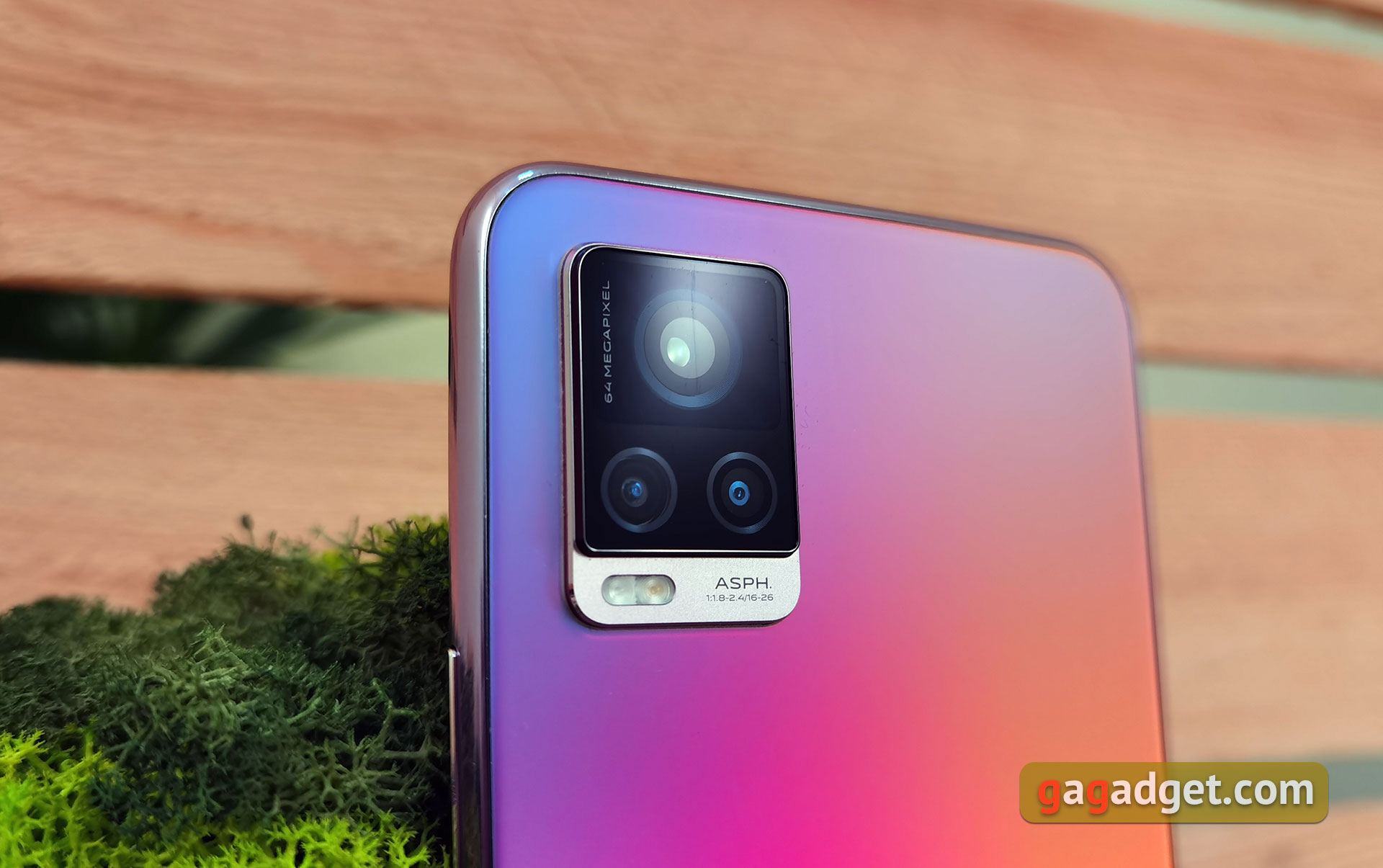
</ img>
In vivo V20, the rear camera includes threemodule. The main one has a resolution of 64 megapixels, an aperture of f/1.9, and phase detection autofocus. There is no optical stabilization. The second module is a wide-angle camera with a viewing angle of 120° with f/2.2 aperture and autofocus. The third module is not very useful: it is a 2 megapixel depth sensor. The maximum video resolution is 4K 30 frames per second. There is digital stabilization in FullHD. Front camera - 44MP f/2.0. The camera application as a whole is quite understandable and all the main logic is almost standard: a carousel of main shooting modes, a menu with additional ones, flash settings, HDR, 2x zoom and filters on the main screen. The zoom is, of course, digital. Switching cameras is not very convenient. On the side there is a circle with the caption “Lens”, by clicking on it you can see the modes “Ultra-wide angle”, “Bokeh” and “Super macro”. Apparently, the macro mode is implemented using “width”.

</ img>

</ img>

</ img>

</ img>

</ img>
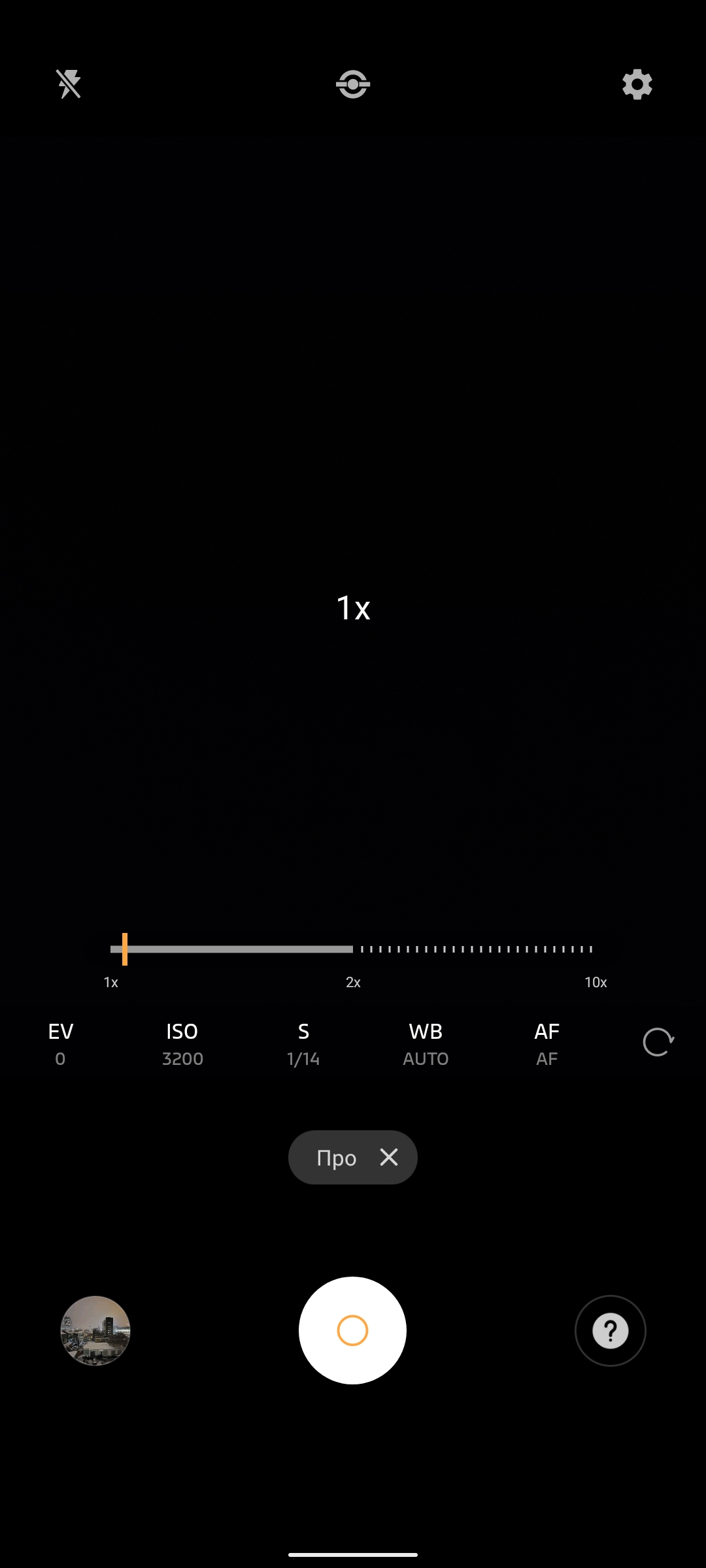
</ img>

</ img>

</ img>

</ img>

</ img>

</ img>

</ img>












The main camera, even despite the absenceoptical stabilization and not the fastest aperture optics, it takes pictures very well. First of all, in good lighting. The night photography capabilities are not amazing, but considering the price category, the smartphone does a very good job. In addition to the usual night mode, there is also a tripod mode with a very long shutter speed. But it’s really not practical to use it without a stop or a tripod. The original photographs are available at the link.

</ img>

</ img>

</ img>

</ img>

</ img>

</ img>

</ img>

</ img>

</ img>

</ img>

</ img>

</ img>

</ img>

</ img>

</ img>

</ img>

</ img>

</ img>

</ img>

</ img>

</ img>

</ img>






















The wide-angle camera pleased with the presenceautofocus, which is still rare. In terms of quality, it also slightly outperforms its competitors: it demonstrates good color rendition and not such a big loss in detail, although it is a little “soapy.” there are some around the edges. Although in low light the detail is significantly reduced:

</ img>

</ img>

</ img>

</ img>

</ img>

</ img>

</ img>

</ img>

</ img>

</ img>

</ img>

</ img>

</ img>

</ img>

</ img>

</ img>

</ img>

</ img>


















Background blur works quite well:

</ img>

</ img>

</ img>



The smartphone can shoot video up to 4K 30 frames per second. The quality is typical for smartphones of the middle price segment: the flagships are still far away.
FullHD video with stabilization:
</ p>In the dry residue. Three things to know about the vivo V20.
- vivo V20 is a mid-price Android smartphone with a 6.44-inch AMOLED display and a Snapdragon 720G processor.
- The smartphone is equipped with all modern wireless interfaces, including NFC.
- vivo V20 is equipped with a good main camera.
Vivo V20 Specifications
Display
AMOLED, 6.44 inches, 2400×1080, 409 ppi
Housing
dimensions: 161.3×74.2×7.4 mm, weight: 171 g
CPU
Qualcomm Snapdragon 720G (8 nm), 2×2.3 GHz Kryo 465 Gold, 6×1.8 GHz Kryo 465 Silver, Adreno 618
RAM
8 GB LPDDR4X
Flash memory
128GB UFS 2.1 + MicroSD
Camera
64 MP with f/1.9 aperture, PDAF + 8 MP ultra-wide-angle 120˚, f/2.2, 2 MP depth sensor; video 2160p@30fps; front camera: 44 MP f/2.45
Wireless technology
Wi-Fi 802.11 b/g/n/ac (dual band, 2.4 and 5 GHz), Bluetooth 5.1 LE (aptX HD, LDAC), NFC, FM
GPS
GPS, A-GPS, GLONASS, BDS, GALILEO
Battery
4000 mAh, non-removable, 33 W fast charging
operating system
Android 11 + Funtouch OS 11
Sim card
2xNanoSIM
Additionally
optical in-screen fingerprint scanner
For those that want to know more:
- Vivo V17 review: competitors, get moving!
- OPPO Reno3 Pro review: successfully simulating the flagship
- Smartphone review realme 6: anti-crisis price fall
- Vivo V15 Pro review: who is new?
- How vivo will conquer Ukraine: an interview with Max Low, CEO of a company in Ukraine
- OPPO Reno2 review: sees what you don't see
- Samsung Galaxy Note10 review: the same flagship, but smaller
- Honor 20 Pro smartphone review: a great camera for sane money